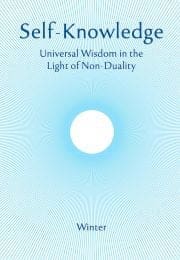Seeing Beyond Differences
The practice of meditation involves both stilling the mind and filling the mind. The two overlap and have the same aim, which is to be free of what seems to separate us from what is most real and fulfilling in ourselves and in all.
We find that stilling the mind relieves us of much tension and distraction, revealing a relative peace and expansiveness. And we find that the most effective way to quieten the inner noise and chatter is to focus on a chosen thought or symbol, an idea with qualities that attract and absorb our full attention.
Ideal subjects for meditation and contemplation are distilled from the non-dual wisdom teaching that our own essence, our self, is awareness-consciousness, which is identical in all human beings. And underlying the outer world of matter and energy is a principle more subtle than physical energy. Ultimately, the realisation is that the Self in everyone, and the Reality in everything, is pure existence-awareness-perfection.
At the time dedicated to meditation practice, we do not discuss or analyse the philosophy behind such statements: we take them as reliable signposts and focus one-pointedly on what they indicate. It is at other times in our life of inquiry that we read or listen to the teachings, and then think deeply about them and integrate the essential ideas into our view of the world.
Here we will reflect on a question at the heart of the non-dual philosophy, remembering that the reason for doing so is to gain an understanding that will resolve confusion and doubts and lead us to inner clarity, serenity and focus.
We hear, and we understand, that ultimately all is one. And this makes sense. How could there be more than one reality? And we find that this oneness can be conceived as comparable to an ocean in which all the objects are like waves. The ocean is vast and continuous and the waves are small and separate; but ultimately the ocean and waves are all water.
With analogies like this we find a way of beginning to recognise unity among diversity, and to see an unchanging, universal reality underlying what is apparently transient and divided.
We know that such analogies are not perfect. There is one way in which the analogy of ocean and waves— and clay and pots and the rest—are clearly inadequate, which could leave us with a restless uncertainty.
It may be said that things relate to the One as waves to water. But objects do have the defining qualities which make them what they are. There is a real difference between rice and sand, between fruits and leaves, even from the same tree, as trying to eat both will confirm!
So in active life, can we really see through the differences and say that all is ultimately one? Can we? Or is it only possible to hold the view of unity in philosophical discussions and meditation sessions, but not in practical life? If so it will bring us limited contentment.
It may be said that the differences and divisions among things belong to appearances and not to reality. Can this distinction solve the difficulty? We know, for example, that the colour of objects depends on the workings of our eyes and nerves. How things appear, taste and the rest, depend on our senses and metabolism. And we know that what seems to be solid matter from our usual point of view turns out to be much less dense when scientifically analysed. Therefore many of the different features of the way things appear, turn out to be just that, appearances rather than entirely real.
To say that the appearance of things is different to how they really are, does not mean that they do not exist in their own way. If we all see a stone and an apple we know that in both cases our senses are interacting with something, and those somethings must be different.
What is that something behind the appearance in each case? Philosophers have called it ‘the thing-in-itself’. Or it may be referred to as the ‘noumenon’, where ‘phenomenon’ means the world of forms as we experience them, and ‘noumenon’ means this ‘thing-in-itself’ behind the appearance.
As students of non-duality, and meditators looking for the direct experience of non-separation, we find a deep question here. We understand that things are not merely ‘all in the mind’; they exist independently of our mind and senses. At the same time, the noumena behind phenomena have their own particular qualities and they change, so that apples are good for eating and stones are good for building, but not the other way around! We find therefore that these things-in-themselves are not just appearances, they obey the laws of cause and effect, and at the same time they are different from the One, the non-dual, the ultimate Reality, which does not come and go, and is not divided in time and space. And so the whole world of forms seems to be not just an appearance and not absolutely Real either. What then is it?
Subscribe or enrol for free guest access to read all of this article and Self-Knowledge online.
Already subscribed or enrolled? Log in:


